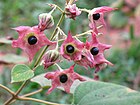Note: This is a project under development. The articles on this wiki are just being initiated and broadly incomplete. You can Help creating new pages.
Difference between revisions of "Clerodendrum infortunatum"
| Line 1: | Line 1: | ||
[[File:പെരിയാലത്തിന്റെ കായ്.jpg|thumb|right]] | [[File:പെരിയാലത്തിന്റെ കായ്.jpg|thumb|right]] | ||
| + | '''Clerodendrum infortunatum''' is a shrub or small tree that can grow from 1 - 5 metres tall. The plant is harvested from the wild for local use as a medicine. It is often grown as an ornamental, valused especially for its aromatic flowers. | ||
==Uses== | ==Uses== | ||
| − | {{Uses|}}, {{Uses|}}, {{Uses|}}, {{Uses|}}, {{Uses|}}, {{Uses|}}, {{Uses| | + | {{Uses|Blenorrhoea}}, {{Uses|Skin problems}}, {{Uses|Stomach pain}}, {{Uses|Burns}}, {{Uses|Ulcers}}, {{Uses|Boils}}, {{Uses|Skin diseases}}. |
==Parts Used== | ==Parts Used== | ||
| − | {{Parts Used|}}, {{Parts Used| | + | {{Parts Used|Leaves}}, {{Parts Used|Roots}}. |
==Chemical Composition== | ==Chemical Composition== | ||
| Line 10: | Line 11: | ||
==Common names== | ==Common names== | ||
| − | {{Common names|sa=|en=|gu=|hi=|kn=|ks=|ml=|mr=|pa=|ta=|te=}} | + | {{Common names|sa=Bhandirah|en=Hill Glory Bower|gu=|hi=Titabhamt|kn=Ibbane, Basavana pada|ks=|ml=Peruku|mr=Bhandira|pa=|ta=Perukilai|te=Gurrapu katilyaku}} |
==Properties== | ==Properties== | ||
| Line 28: | Line 29: | ||
==Habit== | ==Habit== | ||
| − | {{Habit|}} | + | {{Habit|Shrub}} |
==Identification== | ==Identification== | ||
| Line 47: | Line 48: | ||
==Mode of Propagation== | ==Mode of Propagation== | ||
| − | {{Propagation|}} | + | {{Propagation|Seeds}} |
==How to plant/cultivate== | ==How to plant/cultivate== | ||
| − | <ref name="How to plant/cultivate"/> | + | Succeeds in full sun or partial shade. Grows best in a moist but well-drained, humus-rich soil.<ref name="How to plant/cultivate"/> |
==Commonly seen growing in areas== | ==Commonly seen growing in areas== | ||
| − | {{Commonly seen|}}, {{Commonly seen| | + | {{Commonly seen|Thickets}}, {{Commonly seen|Village groves}}. |
==Photo Gallery== | ==Photo Gallery== | ||
| Line 66: | Line 67: | ||
<references> | <references> | ||
| − | <ref name="chemical composition">[ | + | <ref name="chemical composition">[Chemistry]</ref> |
| − | <ref name="Leaf">[" | + | <ref name="Leaf">[Morphology]</ref> |
| + | |||
| + | <ref name="How to plant/cultivate">[http://tropical.theferns.info/viewtropical.php?id=Clerodendrum+infortunatum Cultivation]</ref> | ||
| − | |||
| − | |||
</references> | </references> | ||
Latest revision as of 12:42, 17 April 2020
Clerodendrum infortunatum is a shrub or small tree that can grow from 1 - 5 metres tall. The plant is harvested from the wild for local use as a medicine. It is often grown as an ornamental, valused especially for its aromatic flowers.
Contents
- 1 Uses
- 2 Parts Used
- 3 Chemical Composition
- 4 Common names
- 5 Properties
- 6 Habit
- 7 Identification
- 8 List of Ayurvedic medicine in which the herb is used
- 9 Where to get the saplings
- 10 Mode of Propagation
- 11 How to plant/cultivate
- 12 Commonly seen growing in areas
- 13 Photo Gallery
- 14 References
- 15 External Links
Uses
Blenorrhoea, Skin problems, Stomach pain, Burns, Ulcers, Boils, Skin diseases.
Parts Used
Chemical Composition
Common names
| Language | Common name |
|---|---|
| Kannada | Ibbane, Basavana pada |
| Hindi | Titabhamt |
| Malayalam | Peruku |
| Tamil | Perukilai |
| Telugu | Gurrapu katilyaku |
| Marathi | Bhandira |
| Gujarathi | |
| Punjabi | |
| Kashmiri | |
| Sanskrit | Bhandirah |
| English | Hill Glory Bower |
Properties
Reference: Dravya - Substance, Rasa - Taste, Guna - Qualities, Veerya - Potency, Vipaka - Post-digesion effect, Karma - Pharmacological activity, Prabhava - Therepeutics.
Dravya
Rasa
Guna
Veerya
Vipaka
Karma
Prabhava
Habit
Identification
Leaf
| Kind | Shape | Feature |
|---|---|---|
Flower
| Type | Size | Color and composition | Stamen | More information |
|---|---|---|---|---|
| {{{5}}} |
Fruit
| Type | Size | Mass | Appearance | Seeds | More information |
|---|---|---|---|---|---|
Other features
List of Ayurvedic medicine in which the herb is used
Where to get the saplings
Mode of Propagation
How to plant/cultivate
Succeeds in full sun or partial shade. Grows best in a moist but well-drained, humus-rich soil.[3]
Commonly seen growing in areas
Photo Gallery
References
- ↑ [Chemistry]
- ↑ [Morphology]
- ↑ Cultivation
External Links
- [ ]
- [ ]
- [ ]
Categories:
- Ayurvedic Herbs known to be helpful to treat Blenorrhoea
- Ayurvedic Herbs known to be helpful to treat Skin problems
- Ayurvedic Herbs known to be helpful to treat Stomach pain
- Ayurvedic Herbs known to be helpful to treat Burns
- Ayurvedic Herbs known to be helpful to treat Ulcers
- Ayurvedic Herbs known to be helpful to treat Boils
- Ayurvedic Herbs known to be helpful to treat Skin diseases
- Herbs with Leaves used in medicine
- Herbs with Roots used in medicine
- Herbs with common name in Kannada
- Herbs with common name in Hindi
- Herbs with common name in Malayalam
- Herbs with common name in Tamil
- Herbs with common name in Telugu
- Herbs with common name in Marathi
- Herbs with common name in Sanskrit
- Herbs with common name in English
- Habit - Shrub
- Index of Plants which can be propagated by Seeds
- Herbs that are commonly seen in the region of Thickets
- Herbs that are commonly seen in the region of Village groves
- Herbs
- Pages without herbs images




